Exploring Cloud Computing for Child Virtual International Security
VerifiedAdded on 2023/06/11
|5
|1202
|429
Essay
AI Summary
This reflective essay discusses the potential of cloud computing to address challenges faced by Child Virtual International, particularly in combating child pornography and ensuring online safety. It highlights how cloud computing's strong encryption and data termination processes can be leveraged to block access to harmful content and regulate children's online activities. The essay argues that by implementing cloud computing strategies, such as controlled power access and encrypted data storage, Child Virtual International can effectively monitor and safeguard children in the digital space. The essay references various studies and tests that support the viability of these cloud-based solutions, ultimately concluding that cloud computing can be a valuable tool for protecting children online.
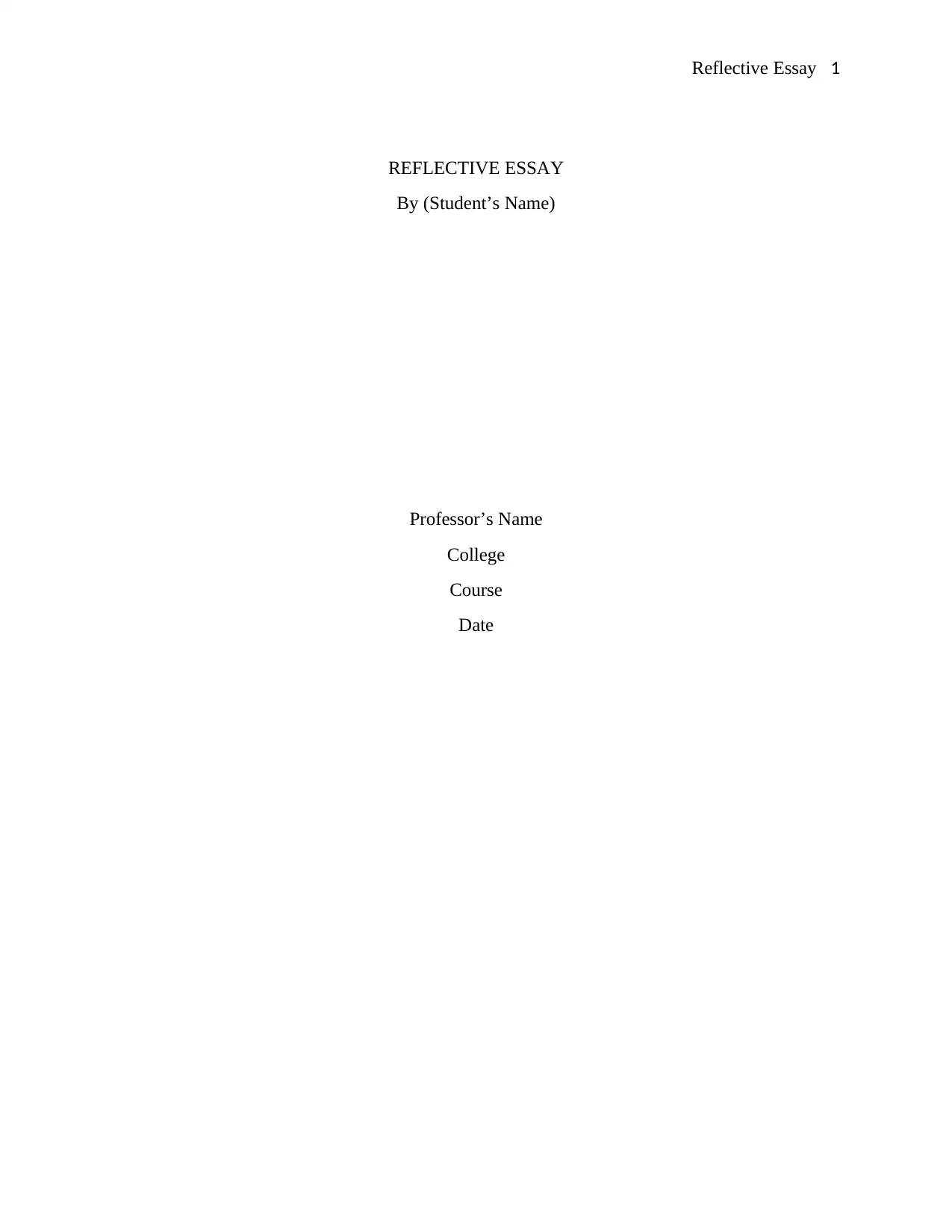
Reflective Essay 1
REFLECTIVE ESSAY
By (Student’s Name)
Professor’s Name
College
Course
Date
REFLECTIVE ESSAY
By (Student’s Name)
Professor’s Name
College
Course
Date
Paraphrase This Document
Need a fresh take? Get an instant paraphrase of this document with our AI Paraphraser
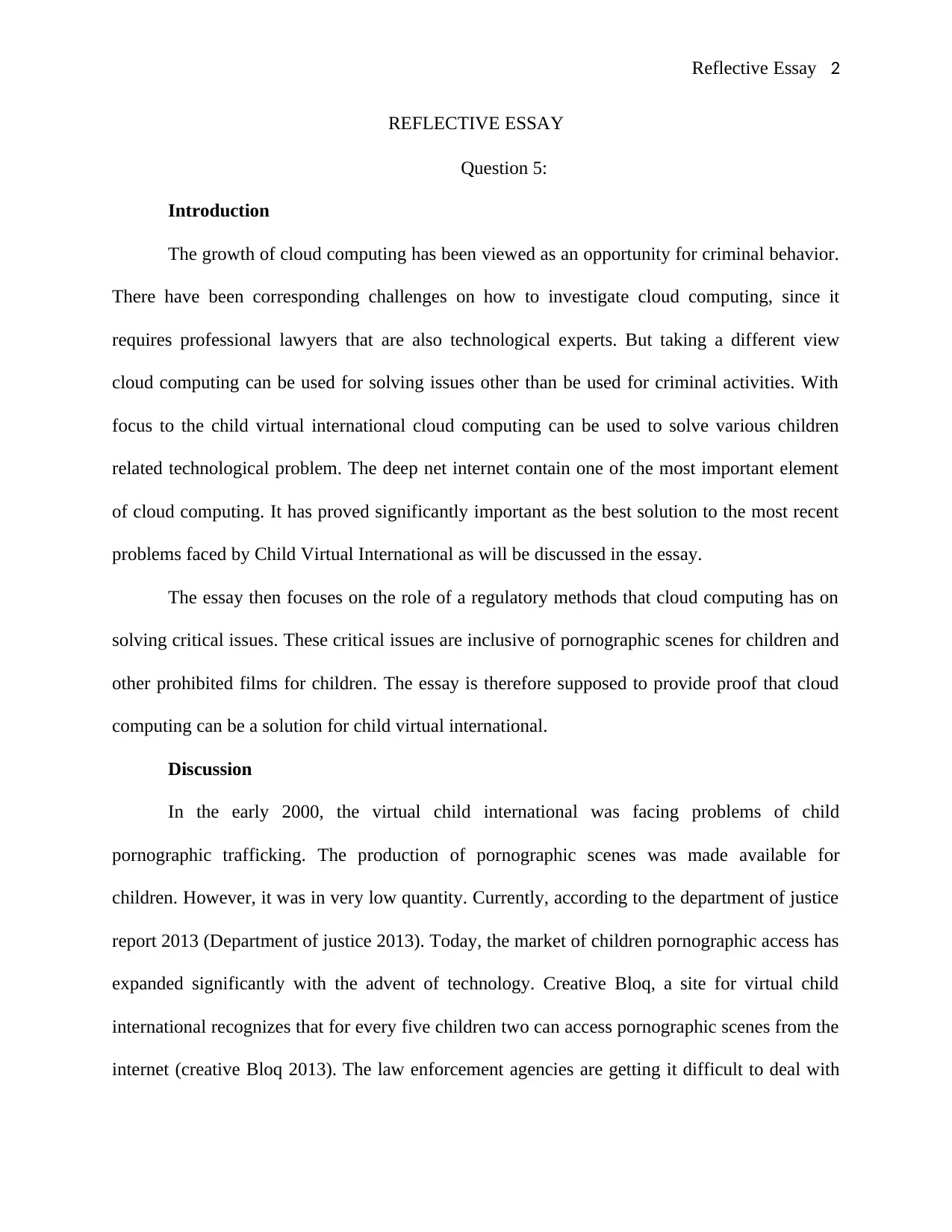
Reflective Essay 2
REFLECTIVE ESSAY
Question 5:
Introduction
The growth of cloud computing has been viewed as an opportunity for criminal behavior.
There have been corresponding challenges on how to investigate cloud computing, since it
requires professional lawyers that are also technological experts. But taking a different view
cloud computing can be used for solving issues other than be used for criminal activities. With
focus to the child virtual international cloud computing can be used to solve various children
related technological problem. The deep net internet contain one of the most important element
of cloud computing. It has proved significantly important as the best solution to the most recent
problems faced by Child Virtual International as will be discussed in the essay.
The essay then focuses on the role of a regulatory methods that cloud computing has on
solving critical issues. These critical issues are inclusive of pornographic scenes for children and
other prohibited films for children. The essay is therefore supposed to provide proof that cloud
computing can be a solution for child virtual international.
Discussion
In the early 2000, the virtual child international was facing problems of child
pornographic trafficking. The production of pornographic scenes was made available for
children. However, it was in very low quantity. Currently, according to the department of justice
report 2013 (Department of justice 2013). Today, the market of children pornographic access has
expanded significantly with the advent of technology. Creative Bloq, a site for virtual child
international recognizes that for every five children two can access pornographic scenes from the
internet (creative Bloq 2013). The law enforcement agencies are getting it difficult to deal with
REFLECTIVE ESSAY
Question 5:
Introduction
The growth of cloud computing has been viewed as an opportunity for criminal behavior.
There have been corresponding challenges on how to investigate cloud computing, since it
requires professional lawyers that are also technological experts. But taking a different view
cloud computing can be used for solving issues other than be used for criminal activities. With
focus to the child virtual international cloud computing can be used to solve various children
related technological problem. The deep net internet contain one of the most important element
of cloud computing. It has proved significantly important as the best solution to the most recent
problems faced by Child Virtual International as will be discussed in the essay.
The essay then focuses on the role of a regulatory methods that cloud computing has on
solving critical issues. These critical issues are inclusive of pornographic scenes for children and
other prohibited films for children. The essay is therefore supposed to provide proof that cloud
computing can be a solution for child virtual international.
Discussion
In the early 2000, the virtual child international was facing problems of child
pornographic trafficking. The production of pornographic scenes was made available for
children. However, it was in very low quantity. Currently, according to the department of justice
report 2013 (Department of justice 2013). Today, the market of children pornographic access has
expanded significantly with the advent of technology. Creative Bloq, a site for virtual child
international recognizes that for every five children two can access pornographic scenes from the
internet (creative Bloq 2013). The law enforcement agencies are getting it difficult to deal with
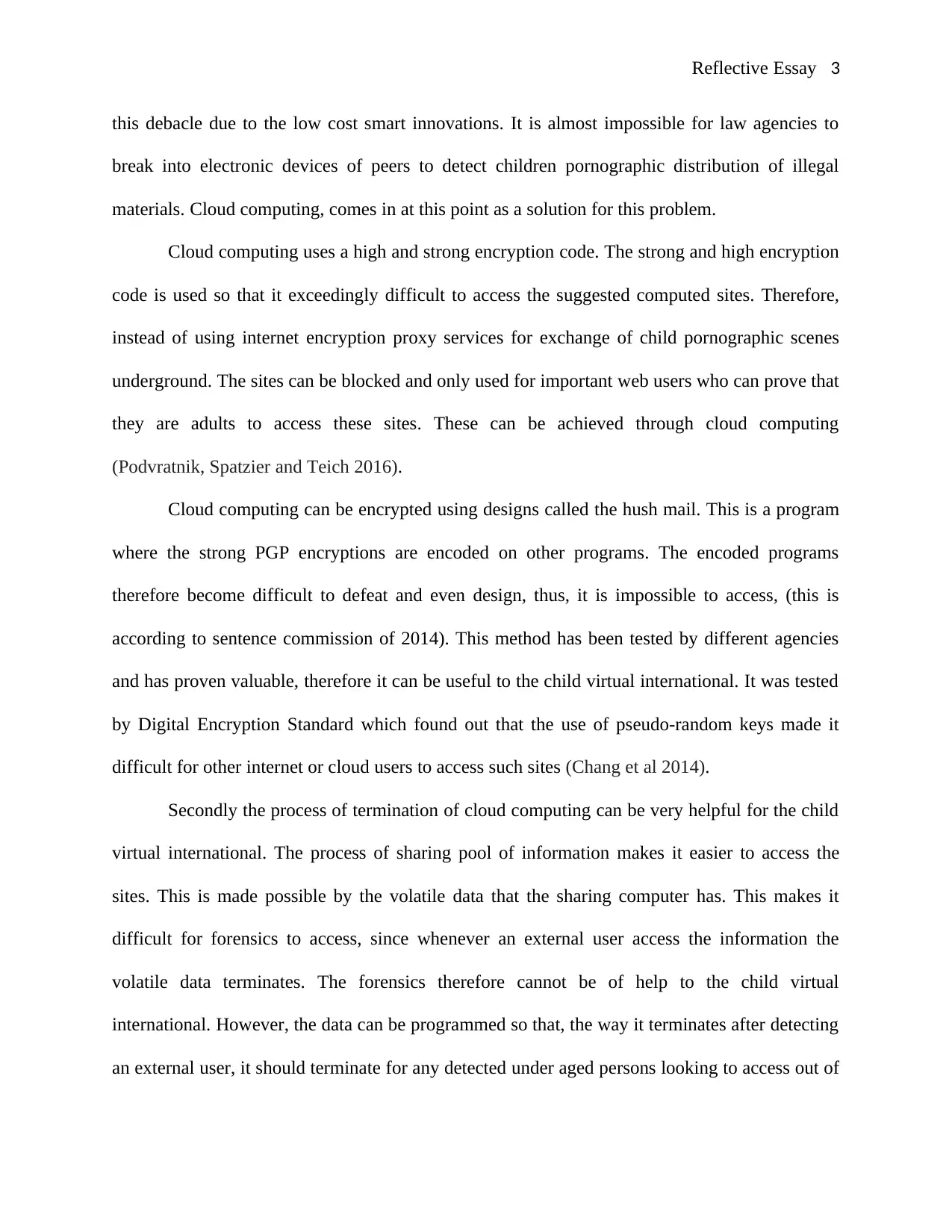
Reflective Essay 3
this debacle due to the low cost smart innovations. It is almost impossible for law agencies to
break into electronic devices of peers to detect children pornographic distribution of illegal
materials. Cloud computing, comes in at this point as a solution for this problem.
Cloud computing uses a high and strong encryption code. The strong and high encryption
code is used so that it exceedingly difficult to access the suggested computed sites. Therefore,
instead of using internet encryption proxy services for exchange of child pornographic scenes
underground. The sites can be blocked and only used for important web users who can prove that
they are adults to access these sites. These can be achieved through cloud computing
(Podvratnik, Spatzier and Teich 2016).
Cloud computing can be encrypted using designs called the hush mail. This is a program
where the strong PGP encryptions are encoded on other programs. The encoded programs
therefore become difficult to defeat and even design, thus, it is impossible to access, (this is
according to sentence commission of 2014). This method has been tested by different agencies
and has proven valuable, therefore it can be useful to the child virtual international. It was tested
by Digital Encryption Standard which found out that the use of pseudo-random keys made it
difficult for other internet or cloud users to access such sites (Chang et al 2014).
Secondly the process of termination of cloud computing can be very helpful for the child
virtual international. The process of sharing pool of information makes it easier to access the
sites. This is made possible by the volatile data that the sharing computer has. This makes it
difficult for forensics to access, since whenever an external user access the information the
volatile data terminates. The forensics therefore cannot be of help to the child virtual
international. However, the data can be programmed so that, the way it terminates after detecting
an external user, it should terminate for any detected under aged persons looking to access out of
this debacle due to the low cost smart innovations. It is almost impossible for law agencies to
break into electronic devices of peers to detect children pornographic distribution of illegal
materials. Cloud computing, comes in at this point as a solution for this problem.
Cloud computing uses a high and strong encryption code. The strong and high encryption
code is used so that it exceedingly difficult to access the suggested computed sites. Therefore,
instead of using internet encryption proxy services for exchange of child pornographic scenes
underground. The sites can be blocked and only used for important web users who can prove that
they are adults to access these sites. These can be achieved through cloud computing
(Podvratnik, Spatzier and Teich 2016).
Cloud computing can be encrypted using designs called the hush mail. This is a program
where the strong PGP encryptions are encoded on other programs. The encoded programs
therefore become difficult to defeat and even design, thus, it is impossible to access, (this is
according to sentence commission of 2014). This method has been tested by different agencies
and has proven valuable, therefore it can be useful to the child virtual international. It was tested
by Digital Encryption Standard which found out that the use of pseudo-random keys made it
difficult for other internet or cloud users to access such sites (Chang et al 2014).
Secondly the process of termination of cloud computing can be very helpful for the child
virtual international. The process of sharing pool of information makes it easier to access the
sites. This is made possible by the volatile data that the sharing computer has. This makes it
difficult for forensics to access, since whenever an external user access the information the
volatile data terminates. The forensics therefore cannot be of help to the child virtual
international. However, the data can be programmed so that, the way it terminates after detecting
an external user, it should terminate for any detected under aged persons looking to access out of
⊘ This is a preview!⊘
Do you want full access?
Subscribe today to unlock all pages.

Trusted by 1+ million students worldwide
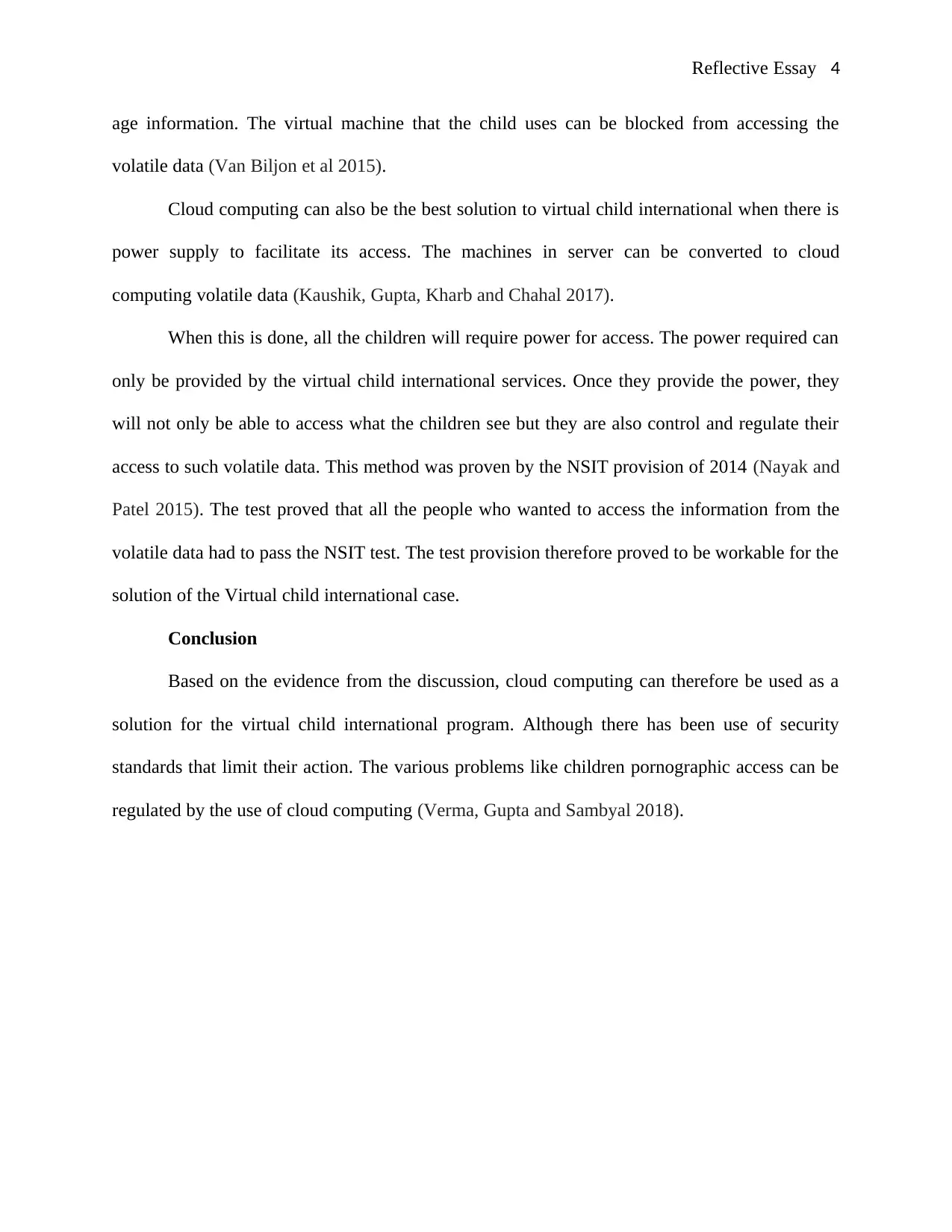
Reflective Essay 4
age information. The virtual machine that the child uses can be blocked from accessing the
volatile data (Van Biljon et al 2015).
Cloud computing can also be the best solution to virtual child international when there is
power supply to facilitate its access. The machines in server can be converted to cloud
computing volatile data (Kaushik, Gupta, Kharb and Chahal 2017).
When this is done, all the children will require power for access. The power required can
only be provided by the virtual child international services. Once they provide the power, they
will not only be able to access what the children see but they are also control and regulate their
access to such volatile data. This method was proven by the NSIT provision of 2014 (Nayak and
Patel 2015). The test proved that all the people who wanted to access the information from the
volatile data had to pass the NSIT test. The test provision therefore proved to be workable for the
solution of the Virtual child international case.
Conclusion
Based on the evidence from the discussion, cloud computing can therefore be used as a
solution for the virtual child international program. Although there has been use of security
standards that limit their action. The various problems like children pornographic access can be
regulated by the use of cloud computing (Verma, Gupta and Sambyal 2018).
age information. The virtual machine that the child uses can be blocked from accessing the
volatile data (Van Biljon et al 2015).
Cloud computing can also be the best solution to virtual child international when there is
power supply to facilitate its access. The machines in server can be converted to cloud
computing volatile data (Kaushik, Gupta, Kharb and Chahal 2017).
When this is done, all the children will require power for access. The power required can
only be provided by the virtual child international services. Once they provide the power, they
will not only be able to access what the children see but they are also control and regulate their
access to such volatile data. This method was proven by the NSIT provision of 2014 (Nayak and
Patel 2015). The test proved that all the people who wanted to access the information from the
volatile data had to pass the NSIT test. The test provision therefore proved to be workable for the
solution of the Virtual child international case.
Conclusion
Based on the evidence from the discussion, cloud computing can therefore be used as a
solution for the virtual child international program. Although there has been use of security
standards that limit their action. The various problems like children pornographic access can be
regulated by the use of cloud computing (Verma, Gupta and Sambyal 2018).
Paraphrase This Document
Need a fresh take? Get an instant paraphrase of this document with our AI Paraphraser
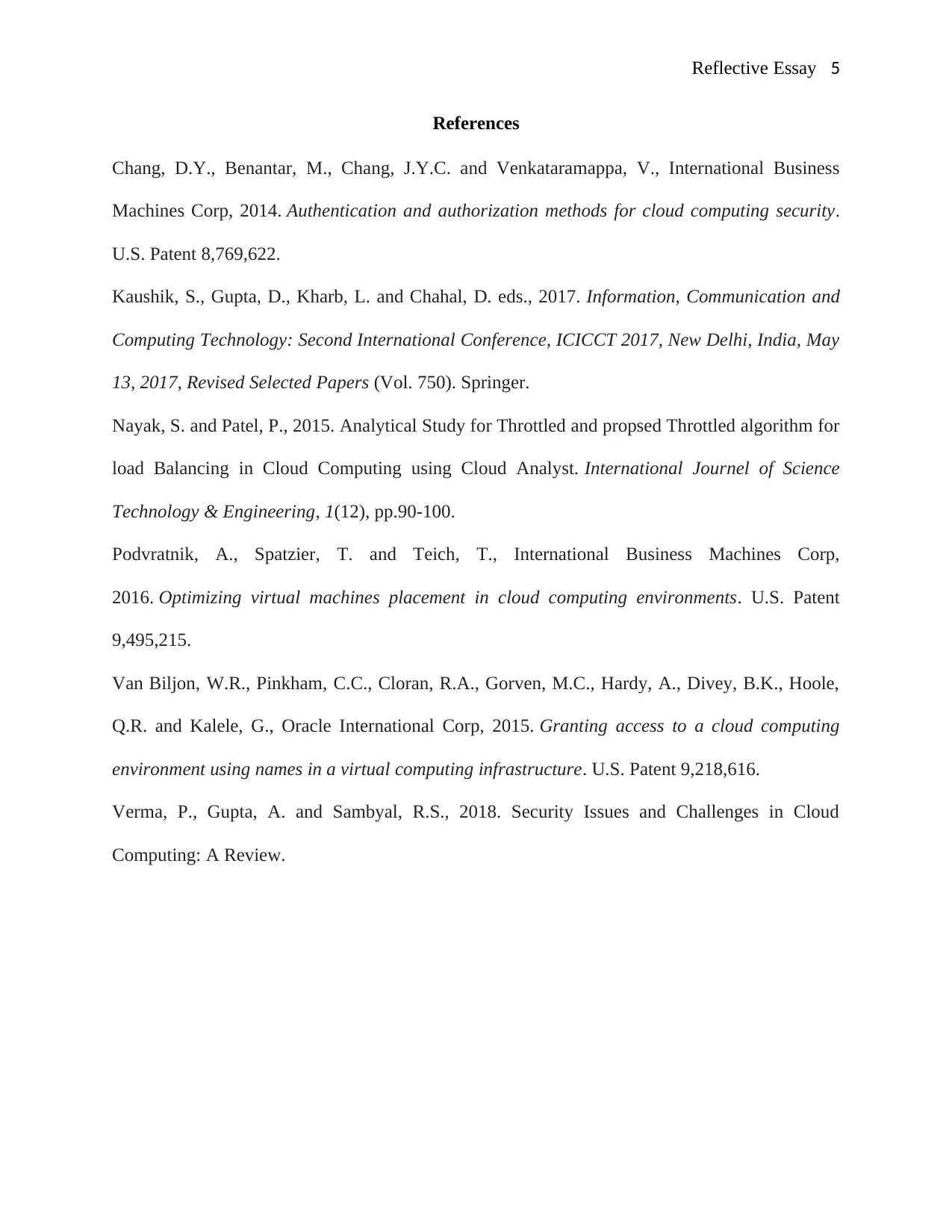
Reflective Essay 5
References
Chang, D.Y., Benantar, M., Chang, J.Y.C. and Venkataramappa, V., International Business
Machines Corp, 2014. Authentication and authorization methods for cloud computing security.
U.S. Patent 8,769,622.
Kaushik, S., Gupta, D., Kharb, L. and Chahal, D. eds., 2017. Information, Communication and
Computing Technology: Second International Conference, ICICCT 2017, New Delhi, India, May
13, 2017, Revised Selected Papers (Vol. 750). Springer.
Nayak, S. and Patel, P., 2015. Analytical Study for Throttled and propsed Throttled algorithm for
load Balancing in Cloud Computing using Cloud Analyst. International Journel of Science
Technology & Engineering, 1(12), pp.90-100.
Podvratnik, A., Spatzier, T. and Teich, T., International Business Machines Corp,
2016. Optimizing virtual machines placement in cloud computing environments. U.S. Patent
9,495,215.
Van Biljon, W.R., Pinkham, C.C., Cloran, R.A., Gorven, M.C., Hardy, A., Divey, B.K., Hoole,
Q.R. and Kalele, G., Oracle International Corp, 2015. Granting access to a cloud computing
environment using names in a virtual computing infrastructure. U.S. Patent 9,218,616.
Verma, P., Gupta, A. and Sambyal, R.S., 2018. Security Issues and Challenges in Cloud
Computing: A Review.
References
Chang, D.Y., Benantar, M., Chang, J.Y.C. and Venkataramappa, V., International Business
Machines Corp, 2014. Authentication and authorization methods for cloud computing security.
U.S. Patent 8,769,622.
Kaushik, S., Gupta, D., Kharb, L. and Chahal, D. eds., 2017. Information, Communication and
Computing Technology: Second International Conference, ICICCT 2017, New Delhi, India, May
13, 2017, Revised Selected Papers (Vol. 750). Springer.
Nayak, S. and Patel, P., 2015. Analytical Study for Throttled and propsed Throttled algorithm for
load Balancing in Cloud Computing using Cloud Analyst. International Journel of Science
Technology & Engineering, 1(12), pp.90-100.
Podvratnik, A., Spatzier, T. and Teich, T., International Business Machines Corp,
2016. Optimizing virtual machines placement in cloud computing environments. U.S. Patent
9,495,215.
Van Biljon, W.R., Pinkham, C.C., Cloran, R.A., Gorven, M.C., Hardy, A., Divey, B.K., Hoole,
Q.R. and Kalele, G., Oracle International Corp, 2015. Granting access to a cloud computing
environment using names in a virtual computing infrastructure. U.S. Patent 9,218,616.
Verma, P., Gupta, A. and Sambyal, R.S., 2018. Security Issues and Challenges in Cloud
Computing: A Review.
1 out of 5
Related Documents
Your All-in-One AI-Powered Toolkit for Academic Success.
+13062052269
info@desklib.com
Available 24*7 on WhatsApp / Email
![[object Object]](/_next/static/media/star-bottom.7253800d.svg)
Unlock your academic potential
Copyright © 2020–2025 A2Z Services. All Rights Reserved. Developed and managed by ZUCOL.



